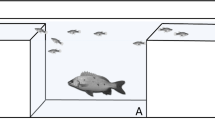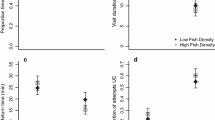Abstract.
The threat-sensitivity hypothesis predicts that prey individuals will increase antipredator behaviors as apparent predator risk increases. An implicit assumption of the threat-sensitivity hypothesis is that predator risk is additive. In other words, all characteristics of a predator that indicate risk should contribute in an additive way to determine the degree of risk-sensitive behavior. We tested this assumption in the laboratory by presenting live predators (green sunfish, Lepomis cyanellus) to groups of western mosquitofish (Gambusia affinis). We examined effects of predator diet, hunger level, and size on predator avoidance and inspection behavior of mosquitofish. Both predator diet and predator hunger level were significant and additive determinants of distance maintained from a predator, resulting in a graded response to combinations of these predator cues. In contrast, whereas predator diet was the most important determinant of general avoidance distances, predator hunger level was more important in determining mosquitofish vertical distribution and inspection behavior. Thus, the relationship between predator cue and the antipredator behavior that it elicits is dependent on which cues and behaviors are examined. Our data suggest that during risky behaviors, such as predator inspection, mosquitofish rely mainly on visual cues (behavior differences between hungry and satiated predators), whereas general avoidance behavior is determined by additive responses from visual and chemical cues.
Similar content being viewed by others
Author information
Authors and Affiliations
Additional information
Electronic Publication
Rights and permissions
About this article
Cite this article
Smith, M.E., Belk, M.C. Risk assessment in western mosquitofish (Gambusia affinis): do multiple cues have additive effects?. Behav Ecol Sociobiol 51, 101–107 (2001). https://doi.org/10.1007/s002650100415
Received:
Revised:
Accepted:
Issue Date:
DOI: https://doi.org/10.1007/s002650100415




